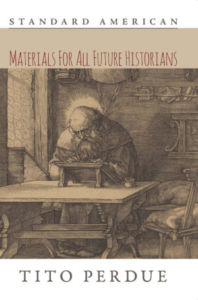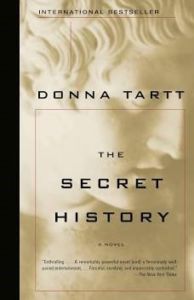Donna Tartt’s The Secret History
2,620 words
The Secret History, originally published in 1992, was Donna Tartt’s first novel, and I admit I approached it backwards, reading her novels The Little Friend and The Goldfinch before tackling this one, which will complete my reviews of her works on this site. It is a compelling and masterfully written tale. Tartt’s style is dense and beautifully descriptive, with passages such as:
My path took me beneath a row of apple trees, full-blown and luminous, shivering in the twilight like an avenue of pale umbrellas. The big white flakes drifted through them, dreamy and soft.
It has a literary magnetism that kept me reading page after page — and at 559 pages, it is not an inconsiderable read. But, as with her preceding works, Tartt’s style is hypnotic and engaging. Her narrative gifts are apparent from the start.
I compared her work with I Am Charlotte Simmons, Tom Wolfe’s novel of college life published in 2004, and from Tartt’s first sentence — “The snow in the mountains was melting and Bunny had been dead several weeks before we came to understand the gravity of our situation” –– I realized that this story of college life was years ahead of Wolfe’s study of academic roistering. But to be fair to Wolfe, he said he imitates Zola, while Tartt admits a deep reverence for Dickens.
The Secret History purports to reach for something deeper than a simple collection of snapshots of college life, drinking, and a student’s struggle to stick to his ideals while being sucked into party life and academia. It aims for the tragic, and has been compared to the Nietzschean struggle between Apollonian and Dionysian man — here, with tragic results.
The story is narrated by Richard Papen, a student from the obscure and dreary world of Plano, California, who arrives at Hampden College, nestled among the Vermont hills, and which may or may not be a reflection of Bennington College, where Tartt studied classical philology and creative writing.
Richard wants to study classical literature, and squeezes his way into the snug coterie of classics scholars. The blurb on the cover states that this group is under the influence of a charismatic Classics professor, but Julian Morrow, the good-natured Professor, is a peripheral character. Richard finds the group to be an array of scholars, or perhaps a wolf pack: there is Francis Abernathy; the twins Charles and Camilla Macauley; Bunny Corcoran, the group’s rowdy, lazy, and opinionated Falstaff; and Henry Winter, a cold, distant, intensely intellectual young man of seductive brilliance who is continually deferred to. Julian may be the professor who supposedly controls and inspires these scholars, but Henry is the group’s captain: He is their brain, the source of their aid and comfort, and, ultimately, an enforcer.
This group and its incestuous isolation sequesters itself from the rest of the campus, which mainly consists of a student body that Tartt depicts as a collection of drunks, dopers, and trust-fund babies who have been dumped into an upper-class college to kill time until graduation. In contrast, the Greek scholars wear coats and ties and converse in Greek as much as possible, in part to master the language but also to pass on secret thoughts and observations. The toast at their secluded parties is “live forever.”
At a campus party, Richard reluctantly hits on a fellow Californian student whom he calls a Cheerleader of the Damned. Between shots, she warns him of the Greeks, those “creepos,” and everything weird about them, especially that they worship the devil.
This only pulls Richard in deeper. He feels inferior due to his California background and makes up his own secret history of coming from a wealthy family and prep school back west in order to fit in with his fellow scholars. In the Classics, he’ll find a form of belonging and social advancement Plano could never offer.
Tartt captures Richard’s ambiguity and the pleasure he takes in this group, throwing himself into getting Greek declensions and tenses right and becoming a grind to the neglect of his other studies — which is Julian’s plan. As in West Side Story, where the gang sings of being a Jet all the way, so it is at Hampden when studying Greek.
Is this coterie of scholars a gang? Slowly, it becomes that way.
I was reminded of The Cabale, Thornton Wilder’s 1926 first novel, where Samuele, a young American scholar, arrives in post-First World War Italy to get mixed up with a group of jaded Europeans. Inevitably, they admit that Europe and its Classical world of gods is dead, and that, sadly or not, America will become the new Olympus. Samuele’s conflict is in reconciling his puritanical upbringing with the pagan life of the European Cabale, and their sense that Americans are the last of the barbarians.
In the 1920s, America was still fresh and new, ready to take over a vibrant classical role from old, bruised Europe. In 2023, the results are now before us.
I will therefore refer to Richard’s group as the cabal, as they are dedicated to knowledge, but also to secrecy, and above all to academic and cultural superiority over the rest of Hampden College. The cabal wear coats and ties. They almost deign to drive cars, but otherwise seem caught in a historical vacuum that Tartt reinforces in her writing. Her novels are take place in the 1980s and 1990s, but the settings suggest America between the 1950s and 2001.
Tartt causes her novels’ physical locations to blend together with the characters, and this practically molds their actions and reasoning. The Little Friend captures the bubble of rural Mississippi, and The Goldfinch a contrast between lively New York and arid, sterile Las Vegas. In The Secret History, Vermont becomes a dark, foreboding locale that can infect its visitors with a kind of unseen evil. In winter, it is a dangerous world; Richard almost dies from its cold but is rescued by Henry, whose ministrations draw Richard closer to the cabal. They then begin to imitate Dionysian reveries in the countryside, as if to conjure the spirit of classical Greece, but here they begin to play with deadly fire. Vermont’s mountains and forests always seem to shape the Cabal. Once they leave the self-absorbed party world of Hampden College, they open themselves to a frenzy they are incapable of coping with.
The setting suggests an almost Stephen King style of evil, but I was reminded of the novels of Charles Brockden Brown (1771-1810), the first serious American novelist, whose gothic style in Edgar Huntly and Wieland describes an American wilderness that infects the minds of worldly, supposedly rational cabals of Americans and Europeans, leading them to acts of murder and madness. Edgar Huntly, absorbed in a nearby brooding mountain called Soulbury, enters its domain and finds himself caught in a savage madness that causes him lose the ability to distinguish between reality and nightmares. He awakens in horror, becoming the very thing he dreaded as he imitates Clithero, a brooding murderer who is considered to have been the inspiration for Mary Shelley’s Frankenstein.
I kept thinking of Brown while reading Tartt, because her prose resembles his gothic style. It could also be said that her writing is reminiscent of Poe, but Poe took his style and themes from Brown, as did Hawthorne. Being a lover of Dickens, I think The Secret History leaves the Dickensian world of urban, middle-class characters behind to venture into darker, more American undercurrents.
What defines this novel is murder. — not in the sense of a whodunnit, but, as Tartt prefers to call it, a why-done-it — but this misses the point. Bunny is murdered when the cabal kills him in a communal act Tartt almost never openly describe. Details come in snippets, but we gather that it was horrible. Bunny — obnoxious, a sponge, sarcastic, and always having to be rescued from financial pains by the grim, long-suffering Henry — is pushed off a cliff, and the police investigation reveals that he fought for his life. But for all the hundreds of pages in this narrative, the actual killing is discreetly draped over.

You can buy Tito Perdue’s Materials for All Future Historians here.
The reason Bunny had to go was because of an earlier murder that is even more obscure than Bunny’s demise — that of Harry Lee Payne, a farmer who is barely mentioned, and we don’t even see his name until 300 pages in.
Richard hears of Bunny’s death from a terrified Camilla, who tells of the cabal’s revels in the woods where they dress in robes and run wild, seeking to imitate a “Dionysiac frenzy” in order to commune with the spirit of the gods. But as Camilla describes it, they suddenly discovered Payne’s body, mutilated, and their own bodies and robes bloodied. Payne’s murder unnerves the group, but Henry forces everyone to keep silent — and it works, except in Bunny’s case, who babbles about it in his cups. When he then threatens to write an account of the deed, his fate is sealed.
Richard, while innocent of Payne’s death, is very much a part of Bunny’s, yet he doesn’t reflect much on it. He mentions how it became the anagnorisis of life to come — a nice, cabal word. Camilla recalls how the murder reminds her of “poor Palinurus” in the Aeneid, but there is little compassion for the lives they took. After Payne was murdered in what could have been a ritualistic murder, Henry forced the cabal to sacrifice a piglet to appease Dionysius, the “fifth” person involved in that night in the woods, but it may as well have been to appease Vermont itself, whose terrain silently looked on. The murders are almost throwaways, occurring offstage as in any true Classical drama — and Tartt is, in many respects, a Classicist.
Henry admits that it would be tough to convince a jury that the killings were the will of Dionysius , and there is little sense of Classical decorum after Bunny’s death. Instead, like true Americans the cabal dips into extended equivocating and goes to maddening lengths to cover their tracks, even considering fleeing the country. As Louis Auchincloss observed, Americans never go down with the ship. Richard observes that the cabal have ways and means to cope with the situation: their trust funds, their family and institutional connections. But he has nothing, and could easily be the patsy if Henry decided that the cabal needs a Lee Harvey Oswald.
This leads to an uneasy feeling I have with The Secret History. While I am enthusiastic about the story, language, descriptions, and Tartt’s page-turning brilliance, there is a moral vacuity at its center. Richard and the other characters are unsympathetic and unlikable people. I found the cabal opaque . Richard, who eventually becomes an English teacher, never seems to mature. He also has dreams of Henry, again recalling Edgar Huntly, where a traumatized Edgar’s psyche has been absorbed by that of the dead Clithero.
I was also surprised by the lack of strong female characters. Camilla is never quite three-dimensional, and a half-hearted romance between her and Richard goes nowhere. If anything, it seems like an early study of the Theo and Pippa romance in The Goldfinch. But romance, in all three books, is never Tarrt’s strong suit.
Certainly Henry stands out in his repressed emotions. When asked about Bunny’s death, he blankly replies, “I prefer to think of it as a redistribution of matter.” He’s far more concerned about his garden than the human beings he dispatches. He’s damned cold, and it’s ironic that Bunny, considered by many readers to be despicable, racist, homophobic, and all the rest of the canards of liberal carping, comes off as the most rounded character in the cabal. He’s like Dickens’ comic characters: We always get them, whereas the serious, noble characters leave us a bit cold.
This is similar to Judy Poovey, another Californian and doper who wanders in and out of the story. She’s actually a very rounded and funny character who sees the cabal for what they are, but Richard, aspiring to be a Classical scholar, can never warm to her.
Tartt again achieves a superb setting by depicting Bunny’s funeral in Connecticut, both a land and an event of both the macabre and humorous. Bunny’s parents are a mix between public embarrassment and social-climbing snottyness. Large funeral wreaths mistakenly delivered to their home “gave that corner of the room a Kentucky Derby sort of look,” and at the funeral, “[s]omeone was ringing the church bell and not doing a very good job of it; it clanged to and fro like a bell at a seance.”
The cabal is forced to spend a night with Bunny’s parents, which nearly drives them nuts, both due to Bunny’s annoying and drunk parents, and the constant praise they keep receiving for having been such good friends to Bunny. It’s a well-written and poignant section, but at 35 pages, does go on and on. As I remarked in previous reviews, Tartt could easily cut 200 pages from each of her novels and lose nothing, and this one is no exception. She is in thrall to giving you a blow-by-blow — but since she won the Pulitzer for The Goldfinch, she’s has no need to change her style.
There are pages and pages of drinking and drugs, and every page describes someone puffing on a cigarette. A rough count would have everyone in the cabal smoking four packs a day; consuming gallons of gin, beer, and whiskey daily; and who knows how many pills they pop. I sincerely hope this is not a reflection of Tartt’s own habits.
The Secret History, despite my reservations about its moral vacuum, is a very satisfying novel and a good beginning for Donna Tartt’s career. A woman I knew read the book three times, and urged me to watch a video where Tartt talks of her days at Bennington, especially the guidance in writing she received from Bret Easton Ellis. But I haven’t. If the cabal in the novel is an example of what these literary greats are like, I’ll avoid it. Are they be as bad as the cabal? As V. S. Naipaul once said, fiction never lies.
Tartt herself in fact dresses in suits and ties, hair bobbed, and strangely resembles her own descriptions of the cabal’s dress and mannerisms. But as they say, write what you know.
There have been critics who claim The Secret History is simply a rewriting of Evelyn Waugh’s Brideshead Revisited and its adulation of snobbery, but I believe Tartt casts a much wider net. I’ve quoted other works that remind me of this novel, and there is no doubt she writes clearly as a voice of serious, American literary fiction.
As it is, the chilled pleasures of Hampden College and its hermetic world of scholars captures an age of campus excess much as I Am Charlotte Simmons did, and reading both books, one would think American schools, and especially their liberal arts departments, are more expensive rehab centers than serious repositories for passing on knowledge.
I won’t fault Tartt for being morally neutral. She may admire Dickens, but she — and we — can do without Dicken’s sermonizing. The Victorians loved it; we’re far more jaundiced. Tartt is a cold camera lens that captures, in a timeless setting, an American world in its late imperial age. The cabal’s supposedly justified murders are only a shadow of the “necessary” wars our own deep-state cabal feels compelled to wage. Children, as they say, will commit the sins of their parents. She offers a remote and analytical view of an America that may be fading, as vampires do when the Sun hits them — or as when Rome, in its last throes, still held islands of Classical culture and decorum even as the barbarians began to blot that world out.
* * *
Like all journals of dissident ideas, Counter-Currents depends on the support of readers like you. Help us compete with the censors of the Left and the violent accelerationists of the Right with a donation today. (The easiest way to help is with an e-check donation. All you need is your checkbook.)
For other ways to donate, click here.


